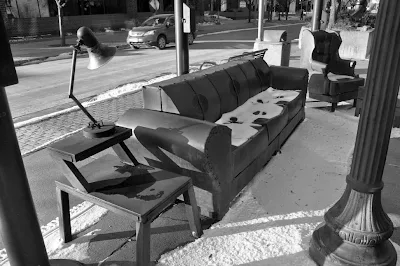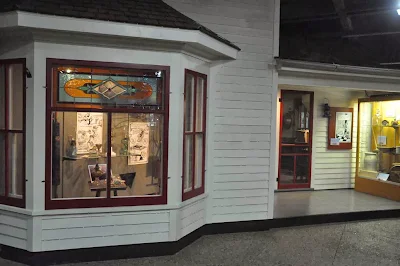Saturday, November 30, 2013
Friday, November 29, 2013
Thursday, November 28, 2013
Wednesday, November 27, 2013
Tuesday, November 26, 2013
Historic Rural SD Housing
This is a claim shanty used by two families to "prove up" two homestead claims in South Dakota after the 1862 Homestead Act signed by President Abe Lincoln. It stood on the property line between the two claims so each family lived on their homestead. Hard to image two large families living in this one room shanty. The 160 acres of government land was "free" after the payment of a small fee, registering the claim, and living on it for five years. But all was not what it seemed. The railroads were granted most of the best land which they sold, their major source of income and profit. The lumber in this shanty was likely delivered by the railroad. Life was never easy on the prairie.
Here is a typical farm house circa 1910 with a wood burning stove for heat and cooking, and the convince of a kitchen with a hand water pump. Many had outside wells with the necessity of carrying water. Upstairs bedrooms were heated, such as they were, by open grills to the warmer first floor.
Here is a typical farm house circa 1910 with a wood burning stove for heat and cooking, and the convince of a kitchen with a hand water pump. Many had outside wells with the necessity of carrying water. Upstairs bedrooms were heated, such as they were, by open grills to the warmer first floor.
Monday, November 25, 2013
Sunday, November 24, 2013
Saturday, November 23, 2013
More Overby Corn Picker
This is where the operator sits controlling six draft horses while running the picker.
Husked ears of corn fall into this bin and are carried up the elevator and into a wagon running along side pulled by two more horses.
Mr. Glenn Overby, son of inventer and builder Frank Overby. He still lives on the family farm outside of Mellette, SD where his father and uncle built this machine completed in 1904.
Husked ears of corn fall into this bin and are carried up the elevator and into a wagon running along side pulled by two more horses.
Mr. Glenn Overby, son of inventer and builder Frank Overby. He still lives on the family farm outside of Mellette, SD where his father and uncle built this machine completed in 1904.
Friday, November 22, 2013
Restored Overby Corn Picker
Thursday, November 21, 2013
Wednesday, November 20, 2013
Tuesday, November 19, 2013
Monday, November 18, 2013
Farm Horse Tractor
I was lucky for the opportunity to drive this tractor as part of its restoration process. Moving parts, including wheels, should be run to show wear for the restoration to be complete. Found this tractor more maneuverable and easy to run than I would have thought. Could see it being useful on a farm. The company was only moderately successful as less expensive tractors out sold them, and they had to go out of business after only a few years of production. Only three Farm Horse tractors are known to still exist. Two of them are at the Agriculture Heritage Museum, Brookings, SD.
Sunday, November 17, 2013
Saturday, November 16, 2013
Jean Pockets
While I admit to having no fashion sense, I'm not sure I understand what is going on with embroidery on women's jeans back pockets. Could it be that women feel a need to draw more attention to their buns? That couldn't be it, could it? Before I receive criticism for this post, I want you to know that I did not sneak up behind a women to photograph her buns. This was a store manikin display for women's jeans.
Friday, November 15, 2013
Thursday, November 14, 2013
Wednesday, November 13, 2013
Tuesday, November 12, 2013
Monday, November 11, 2013
Sunday, November 10, 2013
Saturday, November 9, 2013
Friday, November 8, 2013
Thursday, November 7, 2013
Wednesday, November 6, 2013
Subscribe to:
Posts (Atom)



















































